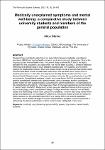Medically unexplained symptoms and mental well-being: a comparative study between university students and members of the general population
| dc.contributor.author | Marler, A. | |
| dc.date.accessioned | 2023-07-27T12:56:19Z | |
| dc.date.available | 2023-07-27T12:56:19Z | |
| dc.date.issued | 2023 | |
| dc.identifier.citation |
Marler, A. (2023) 'Medically unexplained symptoms and mental well-being: a comparative study between university students and members of the general population', The Plymouth Student Scientist, 16(1), pp. 86-108. | en_US |
| dc.identifier.uri | https://pearl.plymouth.ac.uk/handle/10026.1/21077 | |
| dc.description.abstract |
Research has consistently established an association between medically unexplained symptoms (MUS) and mental health concerns, such as anxiety and depression. Due to the ongoing student mental health crisis, the current study predicted MUS would be highly prevalent for this population; an issue which has not yet been explored. It aimed to establish differential prevalence rates of MUS between students and non-students, and to further explore the relationship between MUS and mental health. It was predicted that mental health concerns and MUS would correlate with each other, and that both would occur more in student participants. To test this, the Depression Anxiety Stress Scales short form and General Health Questionnaire – 30 were completed online by 68 university students and 63 non-students. Correlational analyses, t-tests, and a one-factor ANOVA revealed significant positive correlations between both questionnaires, and on average, student participants scored higher on both questionnaires, supporting the current predictions. A small sample of the participants completed 1-1 interviews over Zoom to discuss experiences and perceptions of mental health and MUS. Deductive thematic analysis identified themes both in support of and contradicting current quantitative findings. Findings were interpreted as mental health issues and MUS being overall more prevalent for students, however also being varied within groups and dependent on individuals. Furthermore, the results helped provide the basis for future research on the potential impact MUS are having within the student population. Therefore, future studies of larger and more representative samples would be beneficial in addressing the discussed limitations of the current study highlighted in this paper. | en_US |
| dc.language.iso | en | en_US |
| dc.publisher | University of Plymouth | en_US |
| dc.rights | Attribution 3.0 United States | * |
| dc.rights.uri | http://creativecommons.org/licenses/by/3.0/us/ | * |
| dc.subject | medically unexplained symptoms (MUS) | en_US |
| dc.subject | anxiety | en_US |
| dc.subject | depression | en_US |
| dc.subject | mental health | en_US |
| dc.subject | students. | en_US |
| dc.subject | general public | en_US |
| dc.title | Medically unexplained symptoms and mental well-being: a comparative study between university students and members of the general population | en_US |
| dc.type | Article | en_US |
| plymouth.issue | 1 | |
| plymouth.volume | 16 | |
| plymouth.journal | The Plymouth Student Scientist |




